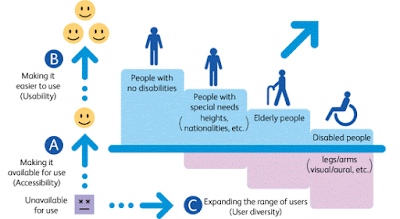Definition by Ronald Mace: “the concept of designing all products and the built environment to be aesthetic and usable to the greatest extent possible by everyone, regardless of their age, ability, or status in life.”
Universal design (UD) is for anyone and everyone. Look around you. Every day you see people of all ages, sizes, capabilities, and the list goes on. Universal Design is a concept that brings together comfort, awareness, understanding, social integration, wellness, personalization, cultural appropriateness, and body fit (click here for specific examples of each entity).
 |
| Image Retrieved from here |
Principle* |
The Design |
Examples for Playspaces |
|---|---|---|
| Equitable Use | Is useful and marketable to people with diverse abilities | Motion-operated automatic doors |
| Flexibility in Use | Accommodates a wide range of individual preferences and abilities | Equipment, benches, chairs, etc. of different heights and sizes |
| Simple and Intuitive Use | Easy to understand, regardless of users experience, knowledge, language skills, or current concentration level | Simple signage easy for all people to interpret |
| Perceptible Information | Communicates necessary information effectively to the user, regardless of ambient conditions or the user’s sensory abilities | Wall, floor, and sidewalk art communicates location |
| Tolerance for Error | Minimizes hazards and the adverse consequences of accidental or unintended actions | Paint splatters on the art room wall allows for children’s mistakes |
| Low Physical Effort | Used effectively and comfortably with a minimum of fatigue | Seamless transition in flooring and playground surfacing |
| Size and Space for Approach and Use | Provides appropriate size and space for approach, reach, manipulation, and use regardless of users body size, posture, or mobility |
Occupational Therapy’s purpose in Universal Design: to increase independence in our client’s, to eliminate architectural barrier’s, to explain the full benefits, and to increase public awareness.


